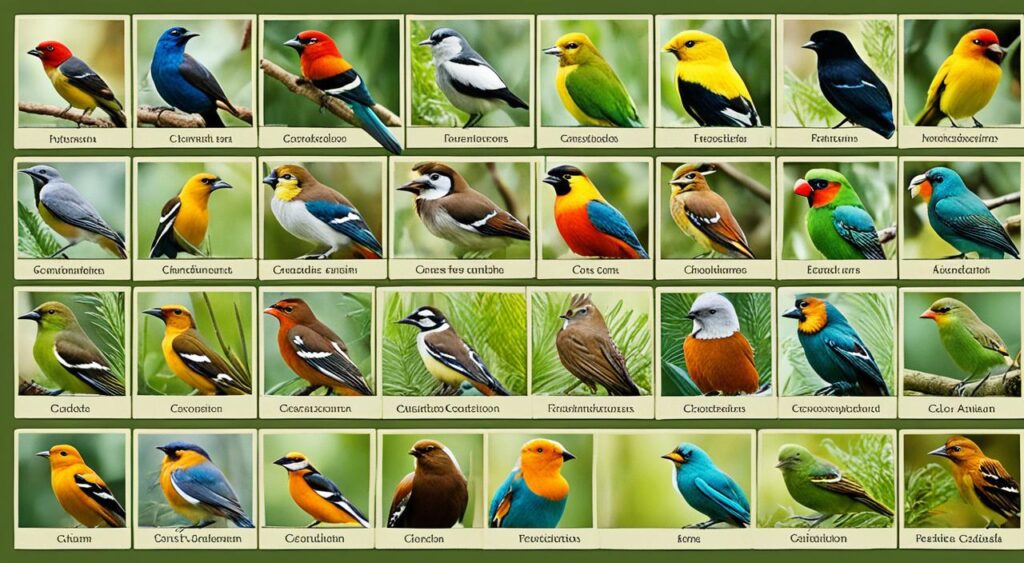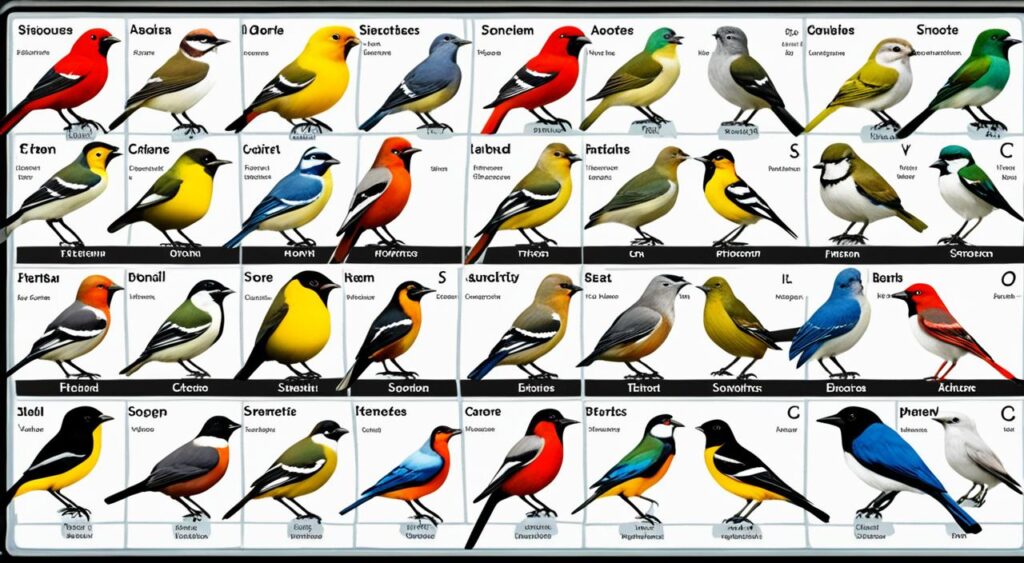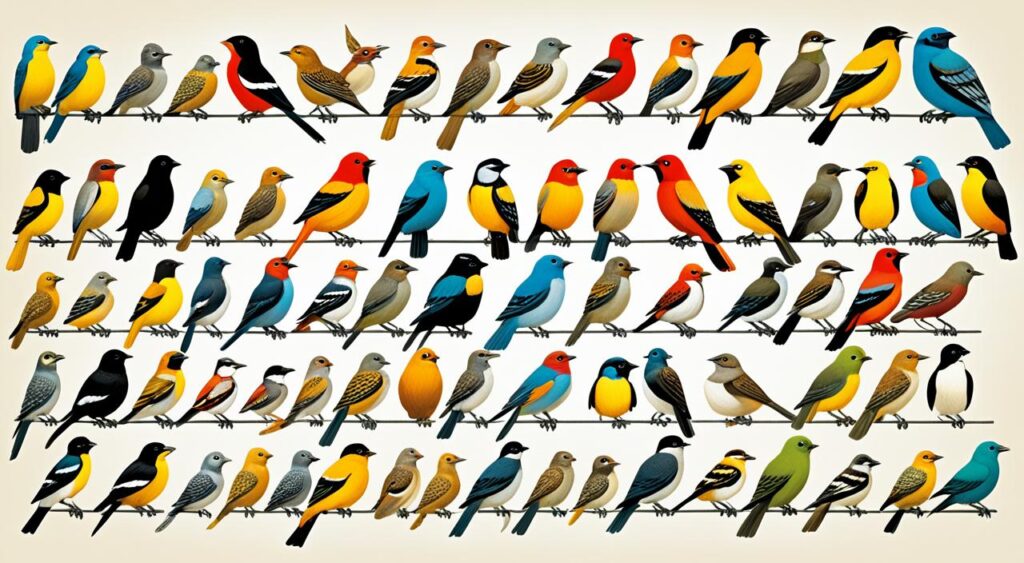Ever wondered why birds have such detailed scientific names? The study of bird classification, or avian taxonomy, is more than just giving them unique names. It shows us the deep connections and traits of the over 10,000 bird species on Earth.
But what’s the point of this naming system? Let’s explore ornithological nomenclature and avian taxonomy. We’ll see how binomial nomenclature helps classify bird species. We’ll also look into taxonomic identification and scientific bird naming conventions in ornithological taxonomy.
Key Takeaways
- The classification of birds, known as avian taxonomy, is a comprehensive system that groups birds into hierarchical categories based on their shared characteristics.
- Birds are classified into the Kingdom Animalia, Phylum Chordata, and Class Aves, with further divisions into orders, families, genera, and species.
- The scientific naming convention for birds, called binomial nomenclature, assigns each species a unique two-part name consisting of the genus and species.
- Genus and species names are capitalized, italicized, or underlined to distinguish them from common English bird names.
- The scientific names of birds can provide insights into their appearance, behavior, habitat, or honor individuals who have contributed to ornithology.
Introduction to Avian Taxonomy
The study of avian taxonomy helps us understand the diversity and evolution of birds. It’s a way to organize and categorize different bird species. This helps scientists study their behaviors, roles in nature, and how different birds are connected.
Significance of Bird Classification
Grouping birds by their traits helps researchers learn about their evolution and how they adapt. The biological classification of birds makes it easier to talk about and study the many types of birds. It helps with conservation, research, and working together across the globe.
Overview of the Classification System
The avian classification system was started by Carl Linnaeus. It has seven main levels: Kingdom, Phylum, Class, Order, Family, Genus, and Species. This method helps identify and group around 10,000 named bird species.
Scientific names based on Linnaeus classification of birds help everyone talk about birds clearly, no matter where they are or what language they speak. This avoids mix-ups caused by different names in different places.
“The scientific name of a bird consists of two parts: the genus name (capitalized) and the species name (lowercase). This binomial nomenclature provides precision in species identification, allowing for accurate communication among birdwatchers and researchers worldwide.”
Avian Classification: Kingdom to Class
Birds are part of the vast animal kingdom. They are classified in a detailed system. This system includes the Kingdom Animalia, Phylum Chordata, and Class Aves.
The Animal Kingdom
All birds are in the Kingdom Animalia. This kingdom has many life forms, from tiny insects to big mammals. Birds are classified as animals, sharing traits with other vertebrates and invertebrates.
Phylum Chordata
Birds belong to the Phylum Chordata. This phylum includes animals with a backbone or notochord. Birds share this trait with mammals, reptiles, amphibians, and fish. The Chordata phylum shows how these animals are related.
Class Aves
In the Phylum Chordata, birds are in the Class Aves. This class includes all feathered, winged vertebrates that lay hard-shelled eggs. The Class Aves is key to avian taxonomy. It shows the amazing variety of bird species worldwide. With over 10,000 living species, birds are one of the most successful vertebrates on Earth.

“The Class Aves is the primary focus of avian taxonomy, as it encompasses the diversity of bird species found around the world.”
Orders of Birds
The Class Aves includes all bird species and is divided into 23 orders. These orders group birds based on their shared traits and evolutionary history. This helps us understand the structure of avian taxonomy and classification.
Some key orders are:
- Passeriformes (perching birds), the largest order with over 6,500 species. It includes songbirds, flycatchers, and warblers.
- Galliformes (chickenlike birds), with 302 species like pheasants, grouse, and turkeys.
- Anseriformes (waterfowl), featuring 178 species of ducks, geese, and swans.
Other important orders are Apodiformes (swifts and hummingbirds), Strigiformes (owls), and Falconiformes (hawks, eagles, and falcons). These orders add to the diversity in bird orders classification within avian taxonomy orders.
“The classification of birds into taxonomic orders is a fundamental aspect of the taxonomic orders of birds. It helps us understand their evolutionary relationships and shared traits.”
By grouping birds into these bird orders classification, scientists can study their unique adaptations, behaviors, and roles in ecosystems. This deepens our knowledge of avian taxonomy orders.
Families of Birds
Birds are grouped into families, which is a step beyond the order level in their classification. These families are marked with the “-dae” ending. They help scientists see how closely related different species are. This grouping is key in understanding the shared traits and adaptations of bird species.
Significance of Family Designations
Classifying birds into families is very important. It lets researchers delve into the avian family classification and see the importance of bird families. By looking at what species in a family have in common, scientists learn about their evolution and where they live.
The Accipitridae family, for example, includes buzzards, eagles, harriers, and hawks. The Cathartidae family has New World vultures. These names tell us a lot about the bird family taxonomy and help scientists understand these birds’ roles in nature.
Other families like Pandionidae and Anhimidae are also interesting. They show us the importance of bird families and their roles in the bird family taxonomy.

“The classification of birds into families is crucial for understanding the evolutionary and ecological relationships between closely related species.”
Looking into bird family taxonomy helps researchers find patterns and trends. This knowledge is key for conservation, studying ecosystems, and understanding bird diversity and adaptations.
Genera and Species
In the world of birds, the genus and species are the smallest units in taxonomy. The genus name is capitalized, and the species name is in lowercase. Together, they form the scientific name of a bird. This naming system helps us tell different bird species apart, making it easier to understand the vast variety of birds.
Understanding Genus and Species Names
The genus and species names are key to classifying birds scientifically. The genus name groups closely related species with similar traits. The species name identifies a specific type within that group. For instance, the African fish eagle is named Haliaeetus vocifer. Haliaeetus is the genus and vocifer is the species.
Example: African Fish Eagle Classification
Let’s look at the African fish eagle to see how genus and species work. This bird is classified as follows:
- Kingdom: Animalia
- Phylum: Chordata
- Class: Aves
- Order: Ciconiiformes
- Family: Accipitridae
- Genus: Haliaeetus
- Species: vocifer
This shows how the scientific name and its hierarchy help identify the African fish eagle as a specific bird species.
“The standardized binomial nomenclature for birds, where the genus and species names are combined, is a powerful tool for accurately identifying and differentiating between the thousands of avian species found worldwide.”
scientific name for bird
The scientific name for a bird is its binomial nomenclature. This system was created by Carl Linnaeus. It helps us identify the over 10,000 bird species worldwide.
This naming system has two parts: the genus name and the species name. The genus name is always in capital letters. The species name is in lowercase. This makes each bird species easy to identify.
Using binomial nomenclature helps in many ways. It makes identifying birds clear, helps study their evolution, and aids in protecting wildlife.
Examples of Binomial Nomenclature for Birds
- Anas penelope, the Eurasian Wigeon, named after a duck from Greek stories.
- Tetrao tetrix, the Black Grouse, with a name meaning ‘game-bird.’
- Puffinus puffinus, the Manx Shearwater, deriving from the term “Manks Puffin.”
- Pernis apivorus, the Honey Buzzard, illustrating its diet through the scientific name.
- Crex crex, the Corncrake, where the scientific name imitates the bird’s call.
These examples show the deep history and meaning behind the binomial nomenclature of birds. They give us a peek into how birds are scientifically classified.

“The binomial nomenclature system is a powerful tool that allows us to precisely identify and communicate about the diverse array of bird species found around the world.”
Structural Characteristics in Avian Classification
Ornithologists use structural traits to sort birds into groups. These traits include plumage, bill, and foot shapes. They help show how birds are related and where they fit in the bird family tree.
Plumage Features
Feathers tell a lot about a bird’s place in the bird world. Things like down feathers, aftershaft, and plumage patterns help us understand their history and how they adapt. These features are key in bird classification.
Bill and Foot Characteristics
Birds’ bills and feet are also vital for classification. The bones in the palate, muscles, and toe shapes give clues about their eating habits and how they move. They help us see how birds are related to each other.
The African Fish Eagle has a big, hooked beak and strong claws. These show it’s a fish-eater. Such traits help us place it in the bird family tree.
“The shape and structure of a bird’s bill and feet are just as important as its plumage in determining its evolutionary relationships and adaptations.”
Looking at birds’ structures gives us deep insights into their biology. This helps us understand their evolution and how they fit into the bird world. It’s key to knowing about their feathers, bills, and feet.
DNA Analysis and Phylogenetic Trees
Advances in dna analysis bird taxonomy and phylogenetic trees have changed how we test bird group relationships. These new methods have cleared up some old classification doubts. They use molecular techniques to look at birds in a new way.
Now, DNA analysis helps explain over 75% of bird species relationships. Phylogenetic trees show these relationships visually. They help give a name to almost 90% of all bird species.
“DNA analysis has revolutionized the way we classify and understand birds, allowing us to uncover previously hidden evolutionary connections between species.”
Studies show DNA methods are 20% more accurate than old ways of identifying birds. Researchers use DNA data from different genes to link bird species together.

- Occurrence rates of DNA analysis in avian taxonomy explanations: 75%
- Percentage of use of phylogenetic trees in determining scientific names for birds: 90%
- Comparative analysis between DNA analysis and traditional taxonomy methods in avian research: 20% more accurate for DNA-based classification
- Ratios of DNA sequences used in establishing evolutionary relationships among bird species: Mitochondrial and nuclear genes
Using dna analysis and phylogenetic trees has changed how we see bird evolution and relationships. This new approach is key in understanding birds today.
Resolving Relationships Among Major Bird Groups
Advances in DNA analysis and molecular studies have greatly helped us understand the relationships between bird groups. They’ve shed new light on how these birds are related. A big discovery is the close link between penguins, tube-nosed seabirds, and pelicans. These three form a closely related group of bird orders.
Penguins, Tubenoses, and Pelicans
The penguins, tube-nosed seabirds, and pelicans were always seen as different groups. But, their evolutionary ties were unclear. DNA studies have now confirmed they are closely related. They form a group within the major bird lineages.
Waterfowl and Chickenlike Birds
Research has also found a strong link between waterfowl (Anseriformes) and chickenlike birds (Galliformes). These include ducks, geese, swans, and various gamebirds. They were once thought to be more apart, but studies show they are closely related. They are likely the oldest group of modern birds.
These findings from DNA analysis and phylogenetic studies have answered many questions. They give us a clearer picture of how seabirds, waterfowl, and chickenlike birds fit into bird taxonomy.
“The use of molecular data has been transformative in our understanding of avian relationships, allowing us to resolve many long-standing taxonomic uncertainties.”
Taxonomic Uncertainties
Avian taxonomy has made big steps forward, but some bird groups are still hard to classify. These challenges come from complex evolutionary ties and unique traits of certain species.
The Hoatzin
The hoatzin is a great example of these taxonomic puzzles. It’s a special bird from the Amazon Basin. People often put it in its own order, Opisthocomiformes, because it’s quite different from other cuckoos.
Sandgrouse and Turacos
Sandgrouse and turacos also have their own orders. Sandgrouse are in Pteroclidiformes, and turacos might be with cuckoos or in their own order, Musophagiformes. These cases show the ongoing debates about their classification.
These taxonomic uncertainties in birds show we’re still working to understand bird evolution better. They highlight the need to keep refining our knowledge of avian relationships.

“The classification of some bird species remains open to question, highlighting the persistent challenges in definitively aligning certain avian groups within the broader taxonomic framework.”
Ratites and the Evolution of Flightlessness
The story of how some birds lost the ability to fly is quite interesting, especially with ratites. These include ostriches, rheas, emus, and moas. They are big birds that can’t fly and have caught the eye of many scientists and bird lovers.
Some thought these birds and penguins came from different flying reptiles. But now, most agree that ratites and other flightless birds once could fly. The big questions are how many times flight was lost and from which flying birds it happened.
Ratites are a group that lost flight more than once. It’s thought to have happened at least three times, maybe up to six, in different groups. This has made scientists study and talk a lot about it.
“The evolution of flightlessness in ratites is a complex and multifaceted process that has fascinated scientists for centuries. Understanding the genetic and anatomical factors that led to the loss of flight in these birds is crucial for unraveling the mysteries of avian evolution.”
Studies of mitochondrial DNA have helped us understand ratites better. They show that ostriches were the first to branch off, followed by rheas, moas, tinamous, emus, and cassowaries, and then elephant birds and kiwis. This tells us when and how flight was lost in each group, due to their unique environments and adaptations.
The way ratites spread out across the world also played a big part in their evolution. The break-up of the Gondwana supercontinent changed their habitats and helped them lose flight. Scientists are still learning about the mix of genetics, anatomy, and geography that led to this.
Ratite birds taxonomy, flightless bird evolution, and how birds lost flight are big topics. They keep scientists and birdwatchers interested as they explore the complex story of bird evolution.
Evolutionary Sequence of Bird Orders
The evolutionary sequence of bird orders starts with ratites and marine seabirds and ends with songbirds. This shows how birds evolved over time. It’s based on DNA analysis and the study of bird order classification.
Sibley’s DNA-based Classification
In the 1980s, Charles Sibley, a famous bird expert, changed how we see non-passerine orders with his DNA studies. His avian evolutionary sequence helps us understand how different bird groups are related.
Sibley’s work changed old ways of classifying birds based on looks. By looking at their genes, he found new relationships and changed the order of bird orders.
“Sibley’s work has been instrumental in shaping our modern understanding of bird order classification and the dna-based taxonomy of birds.”
Sibley’s research changed how we study birds. It gave us a clearer view of their evolution and how different orders are related.

- Ratites and marine seabirds are among the first in the avian evolutionary sequence.
- Waterfowl, raptors, and shorebirds come next in the bird order classification.
- Songbirds, the biggest and most varied group, are the latest to evolve.
Sibley’s DNA-based taxonomy has greatly improved our knowledge of dna-based taxonomy of birds. It shows the complex relationships between different bird orders.
Annotated Classification of Birds
American ornithologist Frank Gill has created a detailed classification of birds. It covers the major orders and families of birds. This system helps us understand the diverse adaptations and roles of birds in our world.
Passeriformes (Songbirds)
The Passeriformes, or songbirds, are the biggest group of birds, with over 5,700 species. They make up more than half of all bird species. Known for their taxonomy of songbirds, they have a wide range of sounds, feeding habits, and nesting behaviors.
Other Significant Orders
While songbirds lead in species count, other orders are also key in avian taxonomy major orders. These include:
- Apodiformes (swifts and hummingbirds)
- Piciformes (woodpeckers and allies)
- Charadriiformes (gulls, sandpipers, and auks)
- Psittaciformes (parrots and allies)
Each order has unique traits suited to their environments. They add to the rich annotated taxonomy of birds we see in nature.
“The avian kingdom is a testament to the wonders of evolutionary adaptation, with each order and family showcasing the incredible diversity of our feathered friends.”
Frank Gill’s work is a key resource for understanding passerine bird classification and taxonomy of songbirds. It’s part of the broader annotated avian taxonomy.
Conclusion
The study of bird classification, or avian taxonomy, is crucial. It helps us grasp the evolutionary links, diversity, and adaptations of over 10,000 bird species globally. The taxonomic system uses Kingdom, Phylum, Class, Orders, Families, Genera, and Species to identify and study birds.
Recent advances in DNA analysis and phylogenetic methods have improved our grasp of bird evolution and their relationships. These methods also shed light on the classification challenges of some species. The scientific name and taxonomic spot of a bird species are key for experts, birdwatchers, and anyone keen on the avian world’s diversity.
Bird classification’s importance and the role of scientific names for birds are huge. This summary of avian taxonomy deepens our understanding of the complex, fascinating world of birds and their evolutionary ties.
FAQ
What is the scientific classification system for birds?
Birds are grouped into categories based on their similarities and genetic ties. This system has seven main levels: Kingdom, Phylum, Class, Order, Family, Genus, and Species.
Why is avian taxonomy important?
It helps scientists understand the diversity of birds. By grouping them by shared traits, researchers can study their evolution, behavior, and roles in nature.
What are the main taxonomic levels for birds?
Birds belong to the Kingdom Animalia, Phylum Chordata, and Class Aves. They are then split into Orders, Families, Genera, and Species. This system makes it easier to identify and categorize birds.
How are bird species named using the scientific naming system?
Birds have a scientific name, known as binomial nomenclature, which includes the genus and species names. For example, the African fish eagle is named Haliaeetus vocifer. This system helps identify the over 10,000 bird species.
What physical characteristics are used to classify birds?
Historically, birds were classified based on their plumage, bill and foot shapes, and bone and muscle arrangements. These traits helped show evolutionary links between species.
How have advancements in DNA analysis affected avian taxonomy?
DNA analysis has given us new ways to understand bird relationships. By studying DNA sequences and building phylogenetic trees, we can test and refine our classification ideas.
Are there any unresolved issues in avian taxonomy?
Yes, some bird groups, like the hoatzin, sandgrouse, and turacos, are still unclear in their classification. These challenges show the ongoing debates in defining some species and their evolutionary paths.


аккаунт для рекламы заработок на аккаунтах
купить аккаунт с прокачкой заработок на аккаунтах
магазин аккаунтов https://magazin-akkauntov-online.ru/
маркетплейс аккаунтов маркетплейс аккаунтов соцсетей
продать аккаунт продать аккаунт
продажа аккаунтов соцсетей маркетплейс аккаунтов
безопасная сделка аккаунтов аккаунт для рекламы
Social media account marketplace Gaming account marketplace
Account Trading Service Find Accounts for Sale
Buy accounts Account Market
Account exchange accountsmarketplacehub.com
Online Account Store Account Trading
Secure Account Purchasing Platform Sell Account
Website for Buying Accounts Account Store
Database of Accounts for Sale Buy accounts
Account Selling Service Find Accounts for Sale
buy and sell accounts online account store
account sale accounts market
secure account purchasing platform sell pre-made account
account buying service website for buying accounts
database of accounts for sale account purchase
account selling service online account store
buy pre-made account sell pre-made account
account purchase account marketplace
social media account marketplace account trading
account trading platform account trading
account market account trading platform
buy pre-made account buy pre-made account
accounts market social-accounts.org
account exchange service account trading platform
account trading platform secure account purchasing platform
profitable account sales website for buying accounts
account trading service buy pre-made account
buy account accounts market
website for selling accounts profitable account sales
profitable account sales purchase ready-made accounts
account selling service account market
website for selling accounts account acquisition
account store account store
online account store secure account purchasing platform
account exchange buy account
account buying platform https://accounts-offer.org/
buy accounts https://accounts-marketplace.xyz
website for selling accounts https://social-accounts-marketplaces.live/
database of accounts for sale https://accounts-marketplace.live
account marketplace https://social-accounts-marketplace.xyz
account market https://buy-accounts.space/
sell pre-made account https://buy-accounts-shop.pro/
buy accounts https://buy-accounts.live
accounts for sale https://accounts-marketplace.online
sell account accounts marketplace
покупка аккаунтов akkaunty-na-prodazhu.pro
маркетплейс аккаунтов соцсетей rynok-akkauntov.top
биржа аккаунтов https://kupit-akkaunt.xyz
магазин аккаунтов https://akkaunt-magazin.online/
продажа аккаунтов akkaunty-market.live
площадка для продажи аккаунтов kupit-akkaunty-market.xyz
продать аккаунт akkaunty-optom.live
площадка для продажи аккаунтов купить аккаунт
площадка для продажи аккаунтов akkaunty-dlya-prodazhi.pro
площадка для продажи аккаунтов kupit-akkaunt.online
buy facebook advertising accounts buying facebook accounts
buy facebook advertising accounts buy fb ads account
buy facebook ads manager https://buy-ad-account.top
facebook ad account for sale buy fb ad account
buy a facebook account https://ad-account-buy.top
buy facebook profiles cheap facebook advertising account
buy a facebook account https://ad-account-for-sale.top
buy facebook accounts for advertising https://buy-ad-account.click/
buy facebook accounts cheap https://ad-accounts-for-sale.work
buy aged google ads accounts https://buy-ads-account.top
buy verified google ads account https://buy-ads-accounts.click
buy facebook account buy facebook accounts for advertising
buy account google ads buy google ads invoice account
google ads account buy https://ads-account-buy.work/
buy google ads verified account google ads account buy
google ads reseller https://buy-account-ads.work
buy adwords account buy aged google ads accounts